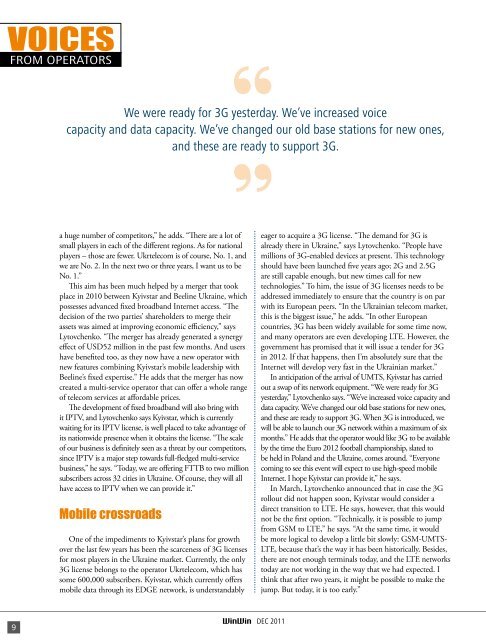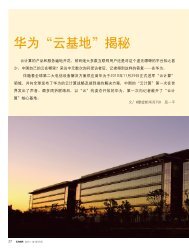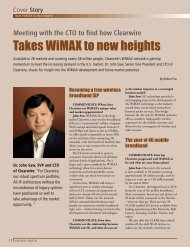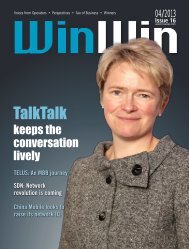Telekom Malaysia - Huawei
Telekom Malaysia - Huawei
Telekom Malaysia - Huawei
You also want an ePaper? Increase the reach of your titles
YUMPU automatically turns print PDFs into web optimized ePapers that Google loves.
VOICES<br />
FROM OPERATORS<br />
We were ready for 3G yesterday. We’ve increased voice<br />
capacity and data capacity. We’ve changed our old base stations for new ones,<br />
and these are ready to support 3G.<br />
a huge number of competitors,” he adds. “There are a lot of<br />
small players in each of the different regions. As for national<br />
players – those are fewer. Ukrtelecom is of course, No. 1, and<br />
we are No. 2. In the next two or three years, I want us to be<br />
No. 1.”<br />
This aim has been much helped by a merger that took<br />
place in 2010 between Kyivstar and Beeline Ukraine, which<br />
possesses advanced fixed broadband Internet access. “The<br />
decision of the two parties’ shareholders to merge their<br />
assets was aimed at improving economic efficiency,” says<br />
Lytovchenko. “The merger has already generated a synergy<br />
effect of USD52 million in the past few months. And users<br />
have benefited too, as they now have a new operator with<br />
new features combining Kyivstar’s mobile leadership with<br />
Beeline’s fixed expertise.” He adds that the merger has now<br />
created a multi-service operator that can offer a whole range<br />
of telecom services at affordable prices.<br />
The development of fixed broadband will also bring with<br />
it IPTV, and Lytovchenko says Kyivstar, which is currently<br />
waiting for its IPTV license, is well placed to take advantage of<br />
its nationwide presence when it obtains the license. “The scale<br />
of our business is definitely seen as a threat by our competitors,<br />
since IPTV is a major step towards full-fledged multi-service<br />
business,” he says. “Today, we are offering FTTB to two million<br />
subscribers across 32 cities in Ukraine. Of course, they will all<br />
have access to IPTV when we can provide it.”<br />
Mobile crossroads<br />
One of the impediments to Kyivstar’s plans for growth<br />
over the last few years has been the scarceness of 3G licenses<br />
for most players in the Ukraine market. Currently, the only<br />
3G license belongs to the operator Ukrtelecom, which has<br />
some 600,000 subscribers. Kyivstar, which currently offers<br />
mobile data through its EDGE network, is understandably<br />
eager to acquire a 3G license. “The demand for 3G is<br />
already there in Ukraine,” says Lytovchenko. “People have<br />
millions of 3G-enabled devices at present. This technology<br />
should have been launched five years ago; 2G and 2.5G<br />
are still capable enough, but new times call for new<br />
technologies.” To him, the issue of 3G licenses needs to be<br />
addressed immediately to ensure that the country is on par<br />
with its European peers. “In the Ukrainian telecom market,<br />
this is the biggest issue,” he adds. “In other European<br />
countries, 3G has been widely available for some time now,<br />
and many operators are even developing LTE. However, the<br />
government has promised that it will issue a tender for 3G<br />
in 2012. If that happens, then I’m absolutely sure that the<br />
Internet will develop very fast in the Ukrainian market.”<br />
In anticipation of the arrival of UMTS, Kyivstar has carried<br />
out a swap of its network equipment. “We were ready for 3G<br />
yesterday,” Lytovchenko says. “We’ve increased voice capacity and<br />
data capacity. We’ve changed our old base stations for new ones,<br />
and these are ready to support 3G. When 3G is introduced, we<br />
will be able to launch our 3G network within a maximum of six<br />
months.” He adds that the operator would like 3G to be available<br />
by the time the Euro 2012 football championship, slated to<br />
be held in Poland and the Ukraine, comes around. “Everyone<br />
coming to see this event will expect to use high-speed mobile<br />
Internet. I hope Kyivstar can provide it,” he says.<br />
In March, Lytovchenko announced that in case the 3G<br />
rollout did not happen soon, Kyivstar would consider a<br />
direct transition to LTE. He says, however, that this would<br />
not be the first option. “Technically, it is possible to jump<br />
from GSM to LTE,” he says. “At the same time, it would<br />
be more logical to develop a little bit slowly: GSM-UMTS-<br />
LTE, because that’s the way it has been historically. Besides,<br />
there are not enough terminals today, and the LTE networks<br />
today are not working in the way that we had expected. I<br />
think that after two years, it might be possible to make the<br />
jump. But today, it is too early.”<br />
9<br />
DEC 2011

















